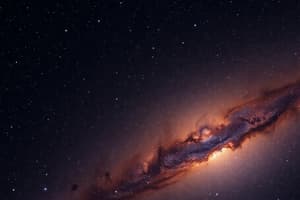Podcast
Questions and Answers
What is the primary focus of astronomy?
What is the primary focus of astronomy?
- Study of black holes
- Study of stars
- Study of the universe (correct)
- Study of planets
The Milky Way Galaxy is a type of elliptical galaxy.
The Milky Way Galaxy is a type of elliptical galaxy.
False (B)
Who was Al Biruni?
Who was Al Biruni?
An Iranian polymath and astronomer.
The ________ is the closest galaxy to the Milky Way.
The ________ is the closest galaxy to the Milky Way.
Match the following galaxies to their descriptions:
Match the following galaxies to their descriptions:
What kind of data do space probes collect?
What kind of data do space probes collect?
Black holes have so much gravity that even light cannot escape from them.
Black holes have so much gravity that even light cannot escape from them.
What significant event in space exploration occurred in the 1950s?
What significant event in space exploration occurred in the 1950s?
The _______ shape of galaxies can become distorted when they collide.
The _______ shape of galaxies can become distorted when they collide.
Which of the following is NOT a component of the universe?
Which of the following is NOT a component of the universe?
What percentage of the universe is made up of dark matter?
What percentage of the universe is made up of dark matter?
Dark matter can be directly observed with telescopes.
Dark matter can be directly observed with telescopes.
What is the primary function of the High Definition Space Telescope?
What is the primary function of the High Definition Space Telescope?
Dark matter is thought to account for approximately ______ percent of the universe.
Dark matter is thought to account for approximately ______ percent of the universe.
Which of the following telescopes has a mirror that is almost twice the size of the James Webb Telescope?
Which of the following telescopes has a mirror that is almost twice the size of the James Webb Telescope?
Match the following celestial objects with their respective descriptions:
Match the following celestial objects with their respective descriptions:
What is the significance of infrared light in astronomy?
What is the significance of infrared light in astronomy?
Celestial objects in space make up more than 10 percent of the total matter in space.
Celestial objects in space make up more than 10 percent of the total matter in space.
Most of the gravity in the universe is thought to be produced by ______.
Most of the gravity in the universe is thought to be produced by ______.
What significant event occurred for Voyager 1 in 2021?
What significant event occurred for Voyager 1 in 2021?
Data from the Voyager spacecraft takes about 20 minutes to reach Earth.
Data from the Voyager spacecraft takes about 20 minutes to reach Earth.
What is the name of the photo taken by Voyager 1 that shows Earth from a great distance?
What is the name of the photo taken by Voyager 1 that shows Earth from a great distance?
Satellites gather climate data, weather patterns, and detect __________.
Satellites gather climate data, weather patterns, and detect __________.
Match the following telescopes with their main features:
Match the following telescopes with their main features:
Which phenomenon do satellites monitor that affects flight patterns?
Which phenomenon do satellites monitor that affects flight patterns?
There are approximately 3400 active satellites orbiting Earth as of 2020.
There are approximately 3400 active satellites orbiting Earth as of 2020.
What is a major consequence of climate change on coral reefs?
What is a major consequence of climate change on coral reefs?
The Aral Sea has been nearly destroyed due to __________ for cotton crops.
The Aral Sea has been nearly destroyed due to __________ for cotton crops.
What type of waves do satellites send out for gathering data?
What type of waves do satellites send out for gathering data?
Flashcards
What is astronomy?
What is astronomy?
The study of the universe and everything in it, including its origin, evolution, and composition.
What is an astronomer?
What is an astronomer?
A person who studies astronomy.
What is the universe?
What is the universe?
Everything that exists, including all matter and energy.
What is a galaxy?
What is a galaxy?
Signup and view all the flashcards
What is a star?
What is a star?
Signup and view all the flashcards
What is a solar system?
What is a solar system?
Signup and view all the flashcards
What is a space probe?
What is a space probe?
Signup and view all the flashcards
What is a black hole?
What is a black hole?
Signup and view all the flashcards
What is the Milky Way?
What is the Milky Way?
Signup and view all the flashcards
What is heliocentric?
What is heliocentric?
Signup and view all the flashcards
Heliosphere
Heliosphere
Signup and view all the flashcards
Voyager 1
Voyager 1
Signup and view all the flashcards
Pale Blue Dot
Pale Blue Dot
Signup and view all the flashcards
Satellites
Satellites
Signup and view all the flashcards
Radar
Radar
Signup and view all the flashcards
Lidar
Lidar
Signup and view all the flashcards
Hubble Telescope
Hubble Telescope
Signup and view all the flashcards
James Webb Telescope
James Webb Telescope
Signup and view all the flashcards
Infrared light
Infrared light
Signup and view all the flashcards
Ozone layer
Ozone layer
Signup and view all the flashcards
Optical/Visible Light
Optical/Visible Light
Signup and view all the flashcards
Dark Matter
Dark Matter
Signup and view all the flashcards
Galaxy
Galaxy
Signup and view all the flashcards
Star
Star
Signup and view all the flashcards
Solar System
Solar System
Signup and view all the flashcards
Universe
Universe
Signup and view all the flashcards
Black Hole
Black Hole
Signup and view all the flashcards
Study Notes
Introduction to Astronomy!
- Astronomy is the study of the universe and everything in it
- Astronomy is the study of the universe and its components. Biruni (973-1043 AD) was a significant Iranian polymath, astronomer, etc.
- Learning goals include knowing the major components of the universe.
Definitions
- Astronomy is the study of the universe.
- An astronomer is a person who studies astronomy.
- The universe is everything that exists, including stars, dust, and galaxies. The universe is made up of the elements found on the periodic table.
Parts of the Universe
- The universe contains galaxies.
- Galaxies contain billions of stars and planets.
- Examples of galaxies mentioned are the Cigar Galaxy, Sombrero Galaxy, Sunflower Galaxy, Cartwheel galaxy, and Andromeda Galaxy (the next closest galaxy to ours).
The Milky Way Galaxy
- Our galaxy is spiral-shaped.
- The Milky Way contains Sagittarius A* (a black hole) in the middle.
- Black holes have immense gravity, not even light can escape them
- Spiral galaxies can be distorted when they collide or get too close to each other.
- Merging galaxies may create supermassive black holes.
- The sun is in the Milky Way galaxy.
Heliocentric Solar Systems & Galaxies
- Galaxies have billions of stars in them.
- Stars have solar systems (planets, asteroids, and dust) orbiting them, these are heliocentric.
Gathering Data
-
Space Probes are unpiloted devices sent from Earth into space.
-
They can land on or float in space.
-
They primarily transmit information by radio.
-
Probes must be able to handle extreme environments.
-
Examples like Voyager 1 & 2, Pioneer 10 & 11, New Horizons, Juno, Cassini, and Galileo have explored the outer planets.
- Voyager 1 & 2 launched in 1977, initially for four years but still operating.
-
Exited the heliosphere (region of the Sun's influence).
-
Data transmission time to Earth varies depending on the target.
-
Some have golden records for communication with other life forms.
-
Satellites orbit planets, gathering data about weather, climate patterns, clouds and military information. Data is gathered by sensors sending out radio waves (radar) or laser light (lidar).
-
Satellites detect air quality, fires, clouds, smoke, and vegetation cover
Telescopes
- Hubble Telescope (1990): A satellite orbiting Earth collecting data on other galaxies.
- James Webb Telescope (2021): Hubble's successor, has a significantly larger gold mirror, enabling detection of infrared light. Webb utilizes infrared light to observe older galaxies.
Dark Matter
- Dark matter is invisible material in the universe.
- It doesn't emit or absorb light, making it undetectable by telescopes.
- It composes roughly 25% of the universe.
- Most of the gravity in the universe is from dark matter.
Practice Questions
- Organize vocabulary words (solar system, dust, galaxy, universe, star, planets) in order from largest to smallest.
- Describe the functions of satellites.
- Compare and contrast Hubble and James Webb telescopes using a Venn diagram.
- Explain dark matter and how it's detected.
- Explain the importance of infrared light in astronomy.
Space Summative
- Review all the gathered information.
Studying That Suits You
Use AI to generate personalized quizzes and flashcards to suit your learning preferences.




